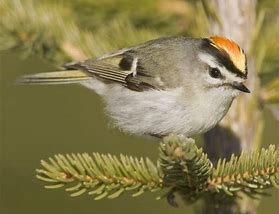Bird of the Month: Kinglets
Ruby-crowned Kinglet Golden-crowned Kinglet
Kinglets are tiny birds of the forest. The Ruby-crowned Kinglet is one of America's smallest birds. It is recognized by its constant wing-flicking. The male shows its red crown only infrequently.
Although the Ruby-crowned Kinglet is small, it lays a large clutch of eggs. Each egg weighs only .02 of an ounce but an entire clutch may weigh as much as the female herself.
Ruby-crowned Kinglets are most often found in spruce-fir forests in the northwestern United States and Canada. They nest high in the trees and prefer older, taller and denser stands to younger ones.
Ruby-crowned Kinglets prey on spiders and many types of insects including aphids, wasps, ants and bark beetles. They will also eat a small amount of seeds and fruit.
Ruby-crowned Kinglets build their nests gathering grasses, feathers, mosses, spiderwebs and cocoon silk for the outer structure and fine plant material and fur for the inner lining. The nest is elastic enough that it can stretch as the brood grows.
Golden-crowned Kinglets are small, continuously active birds most frequently found in coniferous woods. Golden-crowned Kinglets winter northward to Canada and Alaska.
The Golden-crowned Kinglet usually raises two large broods of young despite the short nesting season of the northern boreal forest.
The female Golden-crowned Kinglet feeds her large brood only on the first day after they leave the nest. She then starts laying the second set of eggs while the male takes care of the first brood. The male may have eight or nine young to feed and manages to feed himself and occasionally the incubating female, too.
Each of the Golden-crowned Kinglet's nostrils are covered by a single, tiny feather.
The Golden-crowned Kinglet eats small insects and their eggs.
Golden-crowned Kinglets build their nests with moss, lichen, spider webs and bark strips, lined with feathers, fine grasses, plant down, lichens and fur. The nest hangs from twigs in a tree.


